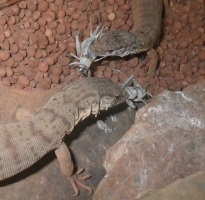With conventional methods, Breeding Crickets can be hard
It is indeed true that crickets used to be the most difficult species of feeder insect to breed
One of the most frequent comments (and myths) Wildlife Hub hears when attending reptile shows or training events is:
“I would love to breed my own crickets, but it’s too hard and takes too much time”.

New Low Maintenance Cricket Breeding Methods
Wildlife Hub’s new methods of breeding crickets, have now made them one of the easiest feeder insects to breed.
The reality is, crickets can now be bred with less maintenance and time than it takes to stand in line at your pet store paying for half dead crickets.
These new methods are very efficient with the average 2 child family producing enough scrap vegetables to produce around $1,400/year. This is enough to feed 4-12 bearded dragons depending on your feeding regime.
When we started breeding feeder insects over 11 years ago, conventional methods resulted in a lot of work and effort (daily spraying, moving crickets from one container to another, preparing breeding substrate, cleaning and feeding), which resulted in 98% giving up after a few months. This is the experience many people have, and is the reason why breeding crickets has such a bad reputation. Consequently these conventional methods were not suited to private or small scale commercial production, and were better suited to medium or large scale production.
Here at WildlifeHub we had to develop simpler, faster and more cost effective private and commercial methods if we were going to have the time to do our research, keep reptiles and do our wildlife rescue work. After over a decade of experimentation we developed a number of systems which streamlines the whole process including; automated food/water dispensers; automated cleaning systems; clever container design and cleaning processes.
Whether you want to breed crickets for private or commercial production, visit our “How to Breed Crickets” page to learn low maintenance cricket breeding methods.
